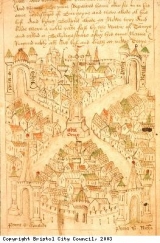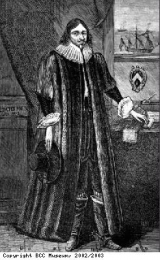The City of Bristol before 18th century
Bristol has been a trading port for 1,000 years. From at least 1300 it was the second largest port after London. The picture here, drawn by the mayor of Bristol’s assistant at the time, shows the size of the city in the 15th century. The plan is from the Mayor’s Calendar, a manuscript book which gives an account of the history of England. In particular, it gives the story of the foundation of Bristol by the heroes Brennus and Belinus, characters from Roman mythical stories.
By the beginning of the 1600s, when it was still a great regional port, Bristol traded mainly with Ireland, France, Spain and Portugal. It also had links with North Africa’s Barbary Coast, the Atlantic islands of Madeira and the Azores (which were then Portuguese), and the Canaries (which were then Spanish). Bristol’s other European trading partners included Hamburg in Germany, Venice in Italy, Holland and the Baltic Sea area (in north eastern Europe). Woollen cloth was the city’s main export along with coal, lead and animal hides. Wine, salt, olive oil, grain and timber were the major products coming in to Bristol.
Bristol also traded with North America and the islands of the Caribbean (off the coast of north America). This trade became important from about 1650, after the English Civil War. By the mid-1660s, tobacco, sugar and other raw materials from the Caribbean and America were coming to Bristol in large quantities. Twenty years later, about 35% of all ships sailing into Bristol were involved in trade with the Caribbean and America. Merchants from the city of Bristol, such as Sir Robert Yeamans, pictured here, became wealthy through early involvement in the Caribbean trade. Sir Robert Yeamans was Sheriff, Mayor and Chief Magistrate of Bristol. His brother John settled on the Caribbean island of Barbados and later founded a slave colony in America.
By 1698, the travel writer Celia Fiennes reported, Bristol “is a very great tradeing citty… and it is esteemed the largest next to London”.




